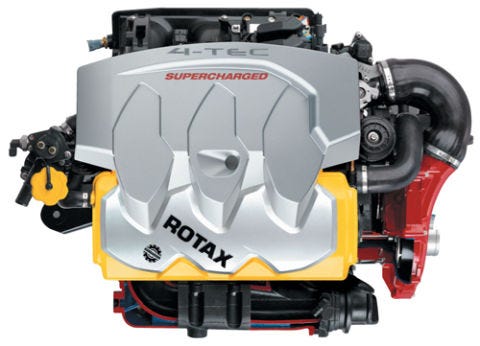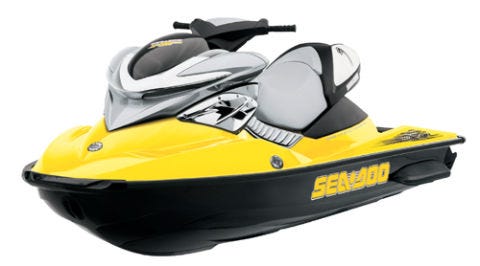2007 Seadoo Rxp 215 Review
It's a shame that PWCs don't have doors. It would be so much fun seeing them blown off by Sea-Doo's RXP--the undisputed new king of personal muscle craft. The closest thing to being shot out of a particle accelerator, on the water, the RXP experience redefines performance with a clean, green 215-hp Rotax engine. How does 0 to 60 mph in 5.5 seconds grab ya, or 0 to 30 mph in 1.8 seconds? And that's with a full tank of gas.
Style With Sizzle
Going fast is cool, but your ride should also look the part. Remember the musclecar '60s and '70s? Hood scoops, shaker hoods, wings, spoilers, fender gills and rocket exhaust tips were the order of the day. Sea-Doo may not have rocket exhaust tips but it does deliver on image, borrowing cues from today's sportbikes. On the downside, we think Sea-Doo is missing the boat, so to speak, by not offering a "Jaws" paint option.
The RXP's supercharged 4-stroke 3-cylinder Rotax SOHC with intercooler features a big-bore (100mm), short-stroke (63.4mm) design. Reduced piston travel means a longer engine life. The heads are a 4-valve design because the RXP mill is redlined at 8 grand. High-revving bike engines that spin at over 11,000 rpm benefit from 5-valve heads. Premium components, such as titanium valves, add to the durability equation, but that stuff doesn't come cheap. Bombardier, the parent company for Sea-Doo, Rotax and other brands, needed volume to justify the engine investment. In addition to powering PWCs, the 4-stroke--dubbed 4 TEC--in various configurations is being bolted into everything from the company's ATVs and snowmobiles to Sea-Doo sport boats.
Engine Evolution
The 4 TEC engine first appeared in the 2002 Sea-Doo 3-passenger GTX platform--the best-selling PWC in the industry that year. Naturally aspirated, the engine produced 155 hp. From the get-go, the 4 TEC was designed to handle the additional power loads demanded by supercharging and intercooling, with no modifications other than ignition tweaking.
In 2003, the engine, still in the GTX hull, was treated to a positive-displacement supercharger making 5 psi boost. This upped the ponies to 185. For '04, blower boost rises to 8.5 psi, and the added intercooler is the icing on the cake. Just as significant, the engine was moved from a 3-passenger cruiser platform to the high-performance 2-up muscle-platform RXP.
The choice to go the supercharging route--versus turbocharging, as Honda has done in its AquaTrax PWC--was based on quicker throttle response. Turbos have to spool up with engine rpm, so there's always some lag. Positive-displacement superchargers are always on boost when you come off idle. Acceleration just snaps--something nice to have if you're towing a skier or wake jumping. The blower is gear driven, and that does suck some horsepower. Sea-Doo claims no weight penalty compared to a turbo.
The supercharger hangs off the rear of the engine, so the top deck and seat width are no wider than that of a 2-stroke machine. This is important in aggressive riding when you need to clench the seat with your knees. Some of those wide cruisers, with their Buick approach to PWCs, make you feel like you're on an elephant safari.
The Straight Scoop
The RXP's hull, based on Sea-Doo's GTi line, is slightly modified with improved chine placement and front spray deflectors. The intake area is widened to process more water. The top deck is totally new, and the rider position, compared to the GTi, is moved forward for a more athletic riding style and quicker turning.
Handling aside, the RXP excels in the same arena as the old musclecars--straight-line performance. It will take you from point A to point B quicker than any other PWC on the water. And it'll blow those craft so far into the weeds, they'll need a GPS to find their way out.

POWER PLAY: The supercharger hangs off the end of the engine, so deck width is kept at a minimum.

LIMITED: Only 9000 Sea-Doo RXPs will be produced for 2004. They'll cost $10,399 each.
This content is created and maintained by a third party, and imported onto this page to help users provide their email addresses. You may be able to find more information about this and similar content at piano.io
Source: https://www.popularmechanics.com/adventure/outdoors/a190/1277266/


Tidak ada komentar: